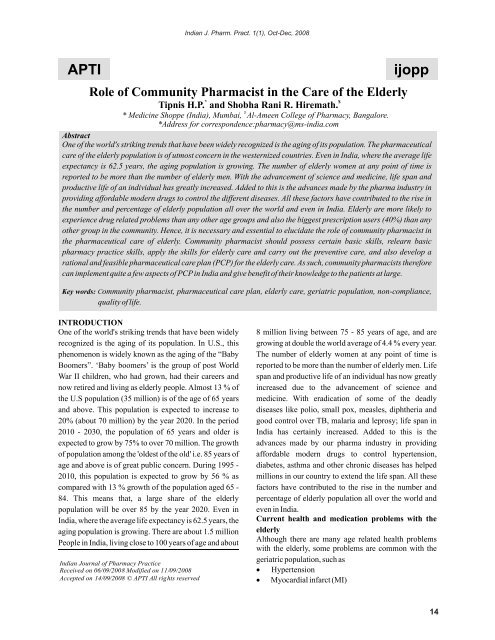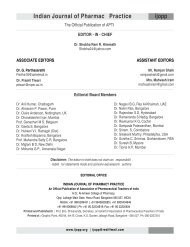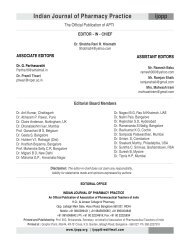APTI ijopp - Indian Journal of Pharmacy Practice
APTI ijopp - Indian Journal of Pharmacy Practice
APTI ijopp - Indian Journal of Pharmacy Practice
Create successful ePaper yourself
Turn your PDF publications into a flip-book with our unique Google optimized e-Paper software.
<strong>Indian</strong> J. Pharm. Pract. 1(1), Oct-Dec, 2008<strong>APTI</strong>Role <strong>of</strong> Community Pharmacist in the Care <strong>of</strong> the Elderly* $Tipnis H.P. and Shobha Rani R. Hiremath.$* Medicine Shoppe (India), Mumbai, Al-Ameen College <strong>of</strong> <strong>Pharmacy</strong>, Bangalore.*Address for correspondence:pharmacy@ms-india.com<strong>ijopp</strong>AbstractOne <strong>of</strong> the world's striking trends that have been widely recognized is the aging <strong>of</strong> its population. The pharmaceuticalcare <strong>of</strong> the elderly population is <strong>of</strong> utmost concern in the westernized countries. Even in India, where the average lifeexpectancy is 62.5 years, the aging population is growing. The number <strong>of</strong> elderly women at any point <strong>of</strong> time isreported to be more than the number <strong>of</strong> elderly men. With the advancement <strong>of</strong> science and medicine, life span andproductive life <strong>of</strong> an individual has greatly increased. Added to this is the advances made by the pharma industry inproviding affordable modern drugs to control the different diseases. All these factors have contributed to the rise inthe number and percentage <strong>of</strong> elderly population all over the world and even in India. Elderly are more likely toexperience drug related problems than any other age groups and also the biggest prescription users (40%) than anyother group in the community. Hence, it is necessary and essential to elucidate the role <strong>of</strong> community pharmacist inthe pharmaceutical care <strong>of</strong> elderly. Community pharmacist should possess certain basic skills, relearn basicpharmacy practice skills, apply the skills for elderly care and carry out the preventive care, and also develop arational and feasible pharmaceutical care plan (PCP) for the elderly care. As such, community pharmacists thereforecan implement quite a few aspects <strong>of</strong> PCP in India and give benefit <strong>of</strong> their knowledge to the patients at large.Key words: Community pharmacist, pharmaceutical care plan, elderly care, geriatric population, non-compliance,quality <strong>of</strong> life.INTRODUCTIONOne <strong>of</strong> the world's striking trends that have been widely 8 million living between 75 - 85 years <strong>of</strong> age, and arerecognized is the aging <strong>of</strong> its population. In U.S., this growing at double the world average <strong>of</strong> 4.4 % every year.phenomenon is widely known as the aging <strong>of</strong> the “Baby The number <strong>of</strong> elderly women at any point <strong>of</strong> time isBoomers”. ‘Baby boomers’ is the group <strong>of</strong> post World reported to be more than the number <strong>of</strong> elderly men. LifeWar II children, who had grown, had their careers and span and productive life <strong>of</strong> an individual has now greatlynow retired and living as elderly people. Almost 13 % <strong>of</strong> increased due to the advancement <strong>of</strong> science andthe U.S population (35 million) is <strong>of</strong> the age <strong>of</strong> 65 years medicine. With eradication <strong>of</strong> some <strong>of</strong> the deadlyand above. This population is expected to increase to diseases like polio, small pox, measles, diphtheria and20% (about 70 million) by the year 2020. In the period good control over TB, malaria and leprosy; life span in2010 - 2030, the population <strong>of</strong> 65 years and older is India has certainly increased. Added to this is theexpected to grow by 75% to over 70 million. The growth advances made by our pharma industry in providing<strong>of</strong> population among the 'oldest <strong>of</strong> the old' i.e. 85 years <strong>of</strong> affordable modern drugs to control hypertension,age and above is <strong>of</strong> great public concern. During 1995 - diabetes, asthma and other chronic diseases has helped2010, this population is expected to grow by 56 % as millions in our country to extend the life span. All thesecompared with 13 % growth <strong>of</strong> the population aged 65 - factors have contributed to the rise in the number and84. This means that, a large share <strong>of</strong> the elderly percentage <strong>of</strong> elderly population all over the world andpopulation will be over 85 by the year 2020. Even in even in India.India, where the average life expectancy is 62.5 years, the Current health and medication problems with theaging population is growing. There are about 1.5 million elderlyPeople in India, living close to 100 years <strong>of</strong> age and aboutAlthough there are many age related health problemswith the elderly, some problems are common with thegeriatric population, such as<strong>Indian</strong> <strong>Journal</strong> <strong>of</strong> <strong>Pharmacy</strong> <strong>Practice</strong>Received on 06/09/2008 Modified on 11/09/2008 HypertensionAccepted on 14/09/2008 © <strong>APTI</strong> All rights reserved Myocardial infarct (MI)14
<strong>Indian</strong> J. Pharm. Pract. 1(1), Oct-Dec, 2008Classical chest painPeripheral vascular disordersChronic stasis ulcersDeep vein thrombosisChronic illnesses and conditions such as diabetes,arthritis, cardiovascular disorders, dementia, etc.Accompanied by the above problems are also secondarydisorders such asUrinary and fecal incontinenceSleep disturbancesAnxiety followed by depressionDisorders <strong>of</strong> GITElderly are also more prone to influenza andpneumoniaTheir medication problems are also linked to their healthproblems. Elderly are more likely to experience drug ormedication related problems than any other age groups.Elderly are the biggest prescription users (40%) than anyother group in the community. It is <strong>of</strong>ten said that “20%elderly population in a community gives 80%prescription business to retail pharmacy”. Other strikingfacts about the use <strong>of</strong> medicines by elderly and theproblems arising out <strong>of</strong> it areNearly 80% <strong>of</strong> the elderly receive inappropriatetherapyOver treatment is <strong>of</strong>ten prescribedElders are more likely to experience drug relatedadverse events (ADEs)By one estimate , nearly 36% <strong>of</strong> all the ADEs happenwith the elderlyOut <strong>of</strong> these 36% ADEs, 28% require hospitalizationNon compliance is another big problem with theelderlyOften, non-compliance <strong>of</strong> the medication regimenleads to sever complications leading tohospitalizationNearly 11% <strong>of</strong> the non-compliance cases among theold results in hospitalizationThe prescription use by the elders increases with age.For example, between 65-69 years old senior citizenshave 13% prescriptions per year, while those between 70-80 years <strong>of</strong> age have 15% prescriptions per year.Nearly 82% <strong>of</strong> the elderly take atleast one drug perday for some disorder or the other.Thus, there is a big challenge and opportunity for acommunity pharmacist to address these drug relatedproblems <strong>of</strong> the elderly and improve their quality <strong>of</strong> life.Role <strong>of</strong> community pharmacist in elderly careEvery community pharmacist is most likely to come incontact with an elderly patient or customer. In somecommunities, this contact may be more frequent than inother communities. For example, if there is a nursinghome nearby or a colony <strong>of</strong> retired elderly people or in awell to do community where joint families live, thesecontacts are bound to be frequent. It is thereforenecessary that a community pharmacist should befamiliar with the tasks that have to be performed for thecare <strong>of</strong> the elderly. But before he/she actually startstaking responsibility <strong>of</strong> the elderly, he/she has to learnsome foundation skills in order to be ready to help theelderly.a) Foundation or Basic skills to be acquired by acommunity pharmacist can be listed as followsFirst <strong>of</strong> all, he/she must display respect andcompassion for the elderlyLearn to use appropriate and cognitive techniques ininteraction with geriatric patients, their families,their care takers and their health care pr<strong>of</strong>essionalsTake personal responsibility for an elderly patientand present yourself as assertive pr<strong>of</strong>essionalLearn to communicate with the elderly in thelanguage and manner by which they will understandclearlyWrite down the important instructions for them insimple and clear languageDemonstrate ethical conduct in all activities relatedto elderly. For example, do not ridicule them or laughat their misunderstanding.b) Relearn basic <strong>Pharmacy</strong> <strong>Practice</strong> skills:To do this, a community pharmacist must do thefollowing-Understand major principles <strong>of</strong> gerontology andgeriatricsDesign and execute investigations <strong>of</strong> geriatricpharmacy practiceIf possible, attend a short term geriatric residencypharmacy practice program in a nearby hospitalLearn to draw an appropriate pharmaceutical careplan (PCP), with other healthcare pr<strong>of</strong>essionalsand/or other inter-disciplinary or multi-disciplinaryteamsWork harmoniously with these teamsUnderstand the alternate care settings for geriatricpatients where they can receive pharmaceutical care,like physiotherapy center or a yoga center wherethey can be taught simple exercises <strong>of</strong> yoga orbreathingUnderstand and learn the use <strong>of</strong> various assistivedevices for the elderly like wheel chairs, trolleysupport walking, supportive neck and waist belts,15
<strong>Indian</strong> J. Pharm. Pract. 1(1), Oct-Dec, 2008Neck caps etc.hand knowledge for providing such services.And finally,And <strong>of</strong>course, he has to interact on regular basis withBe in touch with national and local organizations other healthcare and social service pr<strong>of</strong>essionalsdoing work in geriatric care(and also with non-healthcare pr<strong>of</strong>essionals likeclergy, social workers in the hospitals) in planningBe upto date with current geriatric literature and netand providing care for the elderly.Accept evaluation <strong>of</strong> your work through peer reviewHe also has the responsibility to explain theor through a pr<strong>of</strong>essional organizationeconomic and financial aspects <strong>of</strong> providingc) Applying the above skills for elderly care: pharmacy services to the elderly or their kins whoAfter having acquired these basic skills and positioning are close to them.the pharmacy practice skills in place, a community Preventive care for the elderlyPerhaps, the best contribution that a communitypharmacist can now go ahead with applying these skillspharmacist can do in his setting is to give preventive carefor elderly care. What are some <strong>of</strong> his tasks that he has t<strong>of</strong>or the elderly. It may not be possible for manydo for elderly care? Here are some <strong>of</strong> the tasks that he hascommunity pharmacists, especially in India, to apply theto do to practice elderly care:skills stated above for the elderly care. Many may not beFirst <strong>of</strong> all, he has to identify the seniors in his or even come in contact with other healthcarecommunity who may have high risk for medication pr<strong>of</strong>essionals and work out a combined or collaborativerelated problemsprogram for elderly care. But atleast they can giveHe has to formulate potential solutions to resolve preventive care to help elderly patients in theirand prevent these medication related problems community. This will not only prevent mishaps with theProvide ongoing medication therapy monitoring andelderly, but also prevent some emergency situations. Alsoit will help to prevent adverse drug events (ADEs),assessment to the elderly patientsmedication errors and problems arising out <strong>of</strong> selfObtain detailed medication histories <strong>of</strong> the elderlymedication among elderly.patients by interviews to know their medication Some <strong>of</strong> the guidelines for preventive care are as follows:related problemsTeach the elderly proper use <strong>of</strong> accessories likeApply knowledge <strong>of</strong> geriatric pharmacotherapy to walking stick, rolling walker, neck collars, waistcare for older patients and make the support belts etcrecommendations for appropriate, effective and safeAlso teach them how to prevent falls in home and insurroundings. If possible visit their homes andmedication therapy (remember older patients areinspect their bathrooms and toilet blocks to see if<strong>of</strong>ten over-prescribed).proper supporting bars/handles are installedEngage in verbal and written communications with Regularly check weights <strong>of</strong> the elderly and assesselderly patients and also with other healthcare weight gain or losspr<strong>of</strong>essionalsTake medication review <strong>of</strong> all their prescribed drugsDevelop and demonstrate sensitivity to social and and other auxiliaries like vitamins, dietarypsychological aspects <strong>of</strong> aging process to supplements, herbal medicines that they take onunderstand their impact on medication use. For their own.example, older people <strong>of</strong>ten feel that the drugs are Monitor compliance <strong>of</strong> medicationnot doing any better for them, then why to take so In your setting, set up screening program for the elderlymany drugs. A community pharmacist has to for the followingimpress on them that the drugs are indeed working o Vision Screeningfor better and revive their faith in the medicineso Screening for hearing problemsA community pharmacist also has to observe,o Screening for cognitive impairment (i.e. mentalunderstand and appreciate the medication useprocess in different settings <strong>of</strong> elderly careperception, memory, judgement, reasoning etc)A community pharmacist also has to understand the o Screen for urinary incontinencescope <strong>of</strong> pharmacy services (administrative and o Screen for increased risk from fall in home orclinical) needed for elderly patients and develop first outside16
<strong>Indian</strong> J. Pharm. Pract. 1(1), Oct-Dec, 2008o Screen for blood pressureo Screen for diabetes and for control <strong>of</strong> diabeteso Screen for dementiao Screen for depressiono Screen for height and weight and assess BMIo Screen for osteoporosis by BMD test. Other highend screening can be done with the help <strong>of</strong> a localpolyclinico Oral health screeningo Colorectal cancer screeningo Mammography for breast cancero Cervical cancer screeningo Prostrate cancer screeningo Lipid pr<strong>of</strong>ile screeningBesides these, a community pharmacist must also set upeducational programs for the elderly through distribution<strong>of</strong> simple medical literature on hypertension, diabetes,asthma, osteoporosis etc. Set-up lectures by someexperts, film shows, VCD programs in a community hall.These educational programs can be focused on varioustopics such as appropriate medication use, rational use <strong>of</strong>drugs, prevention <strong>of</strong> medication errors, diseaseprevention and various topics on nutrition and diet etc.The best place to start such educational programs is thesenior citizen's clubs, where you can get a captiveaudience. Community pharmacists should thereforedevelop a good rapport with such clubs and organizations<strong>of</strong> the elderly and participate in their activities on regularbasis.Pharmaceutical care for the elderlyPharmaceutical care has been well defined in manyarticles as “Responsible provision <strong>of</strong> drug therapy for thepurpose <strong>of</strong> achieving definite outcomes that improves apatient's quality <strong>of</strong> life”. Community pharmacists havean excellent opportunity to provide pharmaceutical careand services to the elderly in their settings. There is alsoample evidence that pharmaceutical care can benefit theelderly patients. However, the community pharmacistsmust have a pharmaceutical care plan (PCP) in theirhands which aims to communicate, promote complianceand concordance with treatment (that the elderly arereceiving) and achieve specified therapeutic outcomes.PCP has great potential to not only reduce drug relatedproblems <strong>of</strong> the elderly, but to improve their quality <strong>of</strong>life and overall reduce the expenditure on drugs. Theclinical skills <strong>of</strong> the pharmacists have to be used tomanage the medication therapy <strong>of</strong> the elderly. This willrationalize the use <strong>of</strong> human resources in a communityhealthcare team and reduce the work load <strong>of</strong> the generalpractitioners (GP) in the community.The next big question is how to develop a rational andfeasible pharmaceutical care plan (PCP)? Following aresome steps that can be taken to develop such a PCP:First <strong>of</strong> all, establish a good relationship with thepatient and his doctorCollect relevant information on patient like diseasestate, drugs that he is receiving, clinical tests data etc.All this has to be done by working with his GP andthe patient himselfIdentify drug related (potential) problems among thedrugs he is receiving. Prioritise them in decliningorder, with the most likely first on the listSome <strong>of</strong> the drug related problems can beo Failure to receive the drug by the patiento Untreated indicationo Improper drug selectiono Not receiving proper dosageo May be even receiving an overdose <strong>of</strong> the drugo Adverse drug reaction due the medication thatthe patient is receivingo Drug-Drug interactions (DDI) from among thedrugs written in the prescription for which thereis no indicationEstablish therapeutic goals for each drug relatedproblemIdentify feasible alternative treatment, even withherbal medicinesSelect the best pharmaceutical solution, i.e. bestpossible drug, best suitable formulation <strong>of</strong> the drugand the best suitable doseFinally, get an agreement with the GP <strong>of</strong> the patientand the patient himselfImplement and monitor the planFollow up the plan and measure the outcomesContinue to update the PCP, with the patient's GPand study the outcome.The community pharmacist will have to educate thepatients and their caretakers about the PCP and themedicines that are recommended. He will also have toassist the patients and the caretakers about the need <strong>of</strong>compliance and provide them with compliance aids suchas dose boxes, reminder charts and even send them SMSat appropriate times to ensure compliance. He shouldgive his contact numbers and arrange for his personalvisits to patients' home. The outcome can be measured byClinical parameters like measurement <strong>of</strong> bloodpressure, fasting blood sugar, total cholesterol etc. Inchronic illness, measurement <strong>of</strong> creatinine and bloodUrea can be done17
<strong>Indian</strong> J. Pharm. Pract. 1(1), Oct-Dec, 2008Other simpler methods are, patients' own assessment pharmaceutical care issues in individual patients in a<strong>of</strong> well being their role in the therapyhospital setting. International <strong>Journal</strong> <strong>of</strong> Risk andCorrect response <strong>of</strong> patient to the questions asked Safety in Medicine 2006; 18(2): 99-105.about the therapy.4. Lau E, Dolovich LR. Drug-related problems inAlthough pharmaceutical care plan is a new concept in elderly general practice patients receivingIndia, some <strong>of</strong> the aspects <strong>of</strong> PCP can easily be followed pharmaceutical care. Int. J. Pharm. Pract.by a community or hospital pharmacist are information 2005;13(3):165-77.about the patients, indications, medicines that he is 5. Roughead EE, Semple SJ, Vitry AI. Pharmaceuticalreceiving, possible drug-drug interactions within his care services: A systematic review <strong>of</strong> publishedprescribed drugs, and most important <strong>of</strong> all, the over studies, 1990 to 2003, examining effectiveness inprescribed drugs and unnecessary drugs. Compliance is a improving patient outcomes. Int. J. Pharm. Pract.big problem in India and community pharmacists can 2005;13(1):53-7.play a big role here. Most <strong>of</strong> the failures <strong>of</strong> positive 6. Lam A. Senior care clerkship: An innovativetherapeutic outcomes arise from non-compliance form collaboration <strong>of</strong> pharmaceutical care and learning.India. Community pharmacists therefore can implement Consult. Pharm. 2005;20(1):55-60.quite a few aspects <strong>of</strong> PCP in India and give benefit <strong>of</strong> 7. Crealey GE, Sturgess IK, McElnay JC, Hughes CM.their knowledge to the patients at large.Pharmaceutical care programmes for the elderly:economic issues. Pharmacoeconomics. 2003;REFERENCES: 21(7):455-65.1. Mandavi, Tiwari P and Kapur V. Inappropriate drug 8. Penna RA. Pharmaceutical care. American <strong>Journal</strong>prescribing identified among <strong>Indian</strong> elderly <strong>of</strong> Health-System <strong>Pharmacy</strong> 1999.hospitalized patients. International <strong>Journal</strong> <strong>of</strong> Risk 9. Ross Division. American Academy <strong>of</strong> Familyand Safety in Medicine 2006; 19: 111-116. Physician. Abbott laboratories 2001.2. Mandavi and Tiwari P. Pr<strong>of</strong>ile <strong>of</strong> pharmacotherapy in 10. Tiwari P. Niper Report <strong>Pharmacy</strong> <strong>Practice</strong> Divisionelderly <strong>Indian</strong> patients: Preliminary findings. 2006.International <strong>Journal</strong> <strong>of</strong> Risk and Safety in Medicine 11. Tipnis HP and Rani Shobha RH. Community2006; 18(3): 151-157. <strong>Pharmacy</strong>. Career Publications 2008.3. Tiwari P and Sukhpreet. An investigational study <strong>of</strong> 12. Aging. India Today, 2007 July 30.18
















